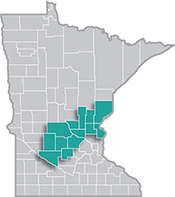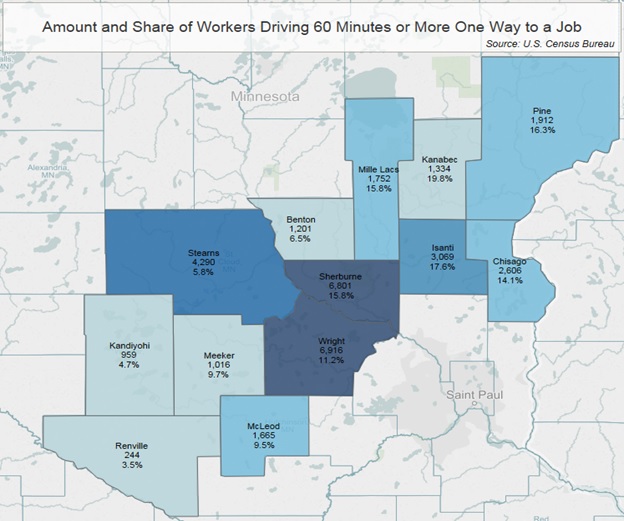 Central Minnesota is a manufacturing stronghold, with several global manufacturing firms operating there.
Central Minnesota is a manufacturing stronghold, with several global manufacturing firms operating there.
The region is especially well known for its expertise in food processing, printing, furniture manufacturing, appliances, machinery and heavy equipment manufacturing.
View our latest blogs on CareerForce. Want the freshest data delivered by email? Subscribe to our regional newsletters.
11/30/2015 10:09:32 AM
Luke Greiner
Most of us don't live in the same place that we work, so every morning we wake up extra early, shuffle out the door, and settle into our car for the daily routine. This routine could include stopping for breakfast or coffee to go, dropping off kids at daycare or school, or topping off the gas tank.
Like most of greater Minnesota, the Central region is a net labor exporter - having more workers than jobs - but is not home to an extensive public transportation network, so many workers drive far distances for their jobs. For a few years I even found myself being a long distance commuter, one of the nearly 34,000 workers in Central Minnesota driving more than 60 minutes to a job EACH WAY! (See Map)

The long commute times in Central Minnesota are due to the proximity to the Twin Cities economy - nearly one-in-five (19.1%) workers in the Central region travel to Hennepin County alone! Wright County is home to the largest amount of road warriors, with almost 7,000 people spending two hours or more driving to and from their job, while Sherburne County nearly matches that amount with about 6,800 long-distance commuters. The St. Cloud MSA (Stearns and Benton County) contributes another 5,500 workers driving more than an hour each way.
Although the four counties in Central Minnesota that border Interstate 94 contribute the largest amount of long distance commuters, the largest share of workers driving 60 minutes or more is found along the northern fringe of the Twin Cities. Almost one-in-five workers living in Kanabec County drive 60 minutes or more, while Isanti and Pine Counties also have more than one-in-six residents driving 60 minutes or more one way for work.
Some costs of long distance commuting are easily measurable, like gas and vehicle maintenance, while others are impossible to assign value to; such as lost family time or how time spent sitting in traffic raises stress levels. Either way, there are significant costs.
A simple analysis can help demonstrate how much long commutes cost in monetary terms. In 2015, the IRS standard mileage reimbursement rate is 57.5 cents per mile*, representing the cost to drive per mile. For easy figuring we'll use a commute distance of roughly 33 miles one way since the national average commute speed by private vehicle was 33.2 miles per hour**. For about 34,000 workers in Central Minnesota, this represents the amount of time and miles they spend driving to their job, especially those commuting into the Twin Cities. However, many folks commuting on Interstate 94 or U.S. Highway 169 could travel considerably further than 33 miles one way. Let's take a look at what it costs to commute an hour each way, or two hours each day.
(33 miles x $.575 cents per mile) x 2 (to and from work) = $38 per day, or $9,500 per year***
Based on IRS reimbursement rates, we know it costs roughly $9,500 per year to commute 60 minutes one way to work, which is a significant amount of money. However, unless you are able to work from home there is typically a cost to commute even short distances. We need to take into consideration what an average commute currently costs. The table below illustrates the additional cost and time spent commuting 60 minutes or more compared to the county average commute times. For example, the average worker in Benton County spends about $3,500 per year on commuting costs, a savings of $6,000 compared to workers driving an hour each way.

The table also shows the additional hours spent commuting. For many, the higher cost is the time away from family, friends, and hobbies. This time spent commuting is much harder to put a monetary value on. For example, long distance commuters from Kandiyohi County who drive at least 60 minutes one way spend an additional 354 hours per year getting to and from work over the average worker, the equivalent of almost nine (9) 40-hour work weeks!
Workers with long-distance commutes may want to look at saving money and time by reducing their travel times. While commuting an hour or more to your job might be necessary if a similar job isn't available locally, knowing the true cost of commuting might change your mind on what you want or need.
Contact Luke Greiner at 320-308-5378.
*The standard mileage rate is based on an annual study of the fixed and variable costs of operating an automobile, including depreciation, insurance, repairs, tires, maintenance, gas and oil.
**2010 Conditions and Performance - Policy
***Yearly cost differences based on 250 work days, (5 work days * 52 weeks) - 2 weeks vacation (10 days) = 250 days